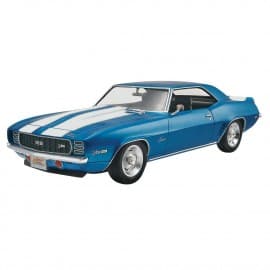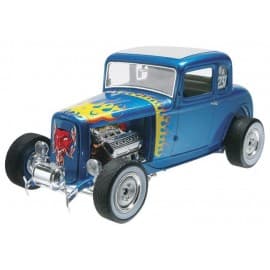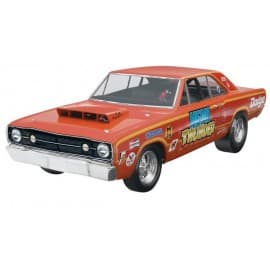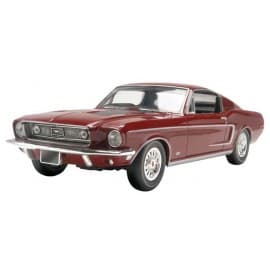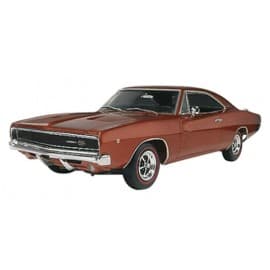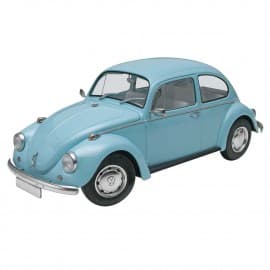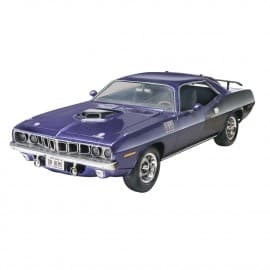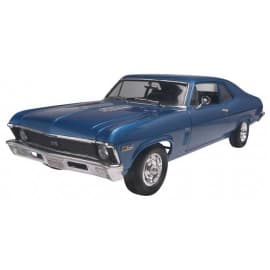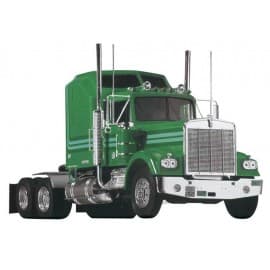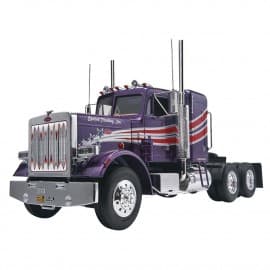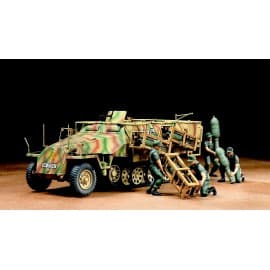Cars & trucks Kits 198 products
Revell 1/25 '69 Chevy Camaro Z28 RS
This is a 1/25 Scale 1969 Camaro Z/28 RSPlastic Model Kit from Revell.Suitable for Ages 14 & Older. Learn more...
Revell 1/25 '68 Dodge Hemi Dart 2 'n 1
This is the 1/25 Scale 1968 Dodge Hemi Dart 2'n1 Special EditionPlastic Model Kit from Revell.Suitable for Ages 14 & Older. Learn more...
Revell 1/25 '68 Dodge Charger 2 'n 1
This is the 1/25 Scale '68 Dodge Charger 2 'n 1Plastic Model Kit from Revell.Suitable for Ages 14 & Older. Learn more...
Revell 1/24 60's Beetle Type 1
This is the 1/24 Scale '68 Volkswagen BeetlePlastic Model Kit from the California Wheels Series by Revell.Suitable for Ages 12 & Older. Learn more...
Revell 1/24 '71 Hemi Cuda 426
This is the 1/24 Scale 1971 Plymouth Hemi CudaPlastic Model Kit from Revell.Suitable for Ages 12 & Older. Learn more...
Revell 1/24 Shelby Mustang GT-350H
This is a 1/24 Scale 1966 Shelby Mustang GT-350HPlastic Model Kit by Revell.Suitable for Ages 12 & Older. Learn more...
Revell 1/25 Kenworth W900 Semi Tractor
This is the 1/25 Scale Kenworth® W900Plastic Model Kit from Revell®.Suitable for Ages 12 & Older. Learn more...
Revell 1/25 Peterbilt 359 Conventional Semi Tractor
This is the 1/25 Scale Peterbilt 359 Conventional TruckPlastic Model Kit from Revell.Suitable for Ages 12 & Older. Learn more...
What are Plastic Model Kits of Cars and Trucks?
Plastic model kits are miniature models of cars and trucks that come in pieces that need to be put together. They are usually made of plastic and can be assembled with glue and paint. They come in a variety of sizes and styles, from realistic replicas of classic cars to cartoonish versions of monster trucks.
What are the Benefits of Building Plastic Model Kits?
Building plastic model kits is a great hobby for car and truck enthusiasts. It’s a fun and rewarding way to express creativity and explore the world of cars and trucks. Plastic model kits are also a great way to learn about the history of cars and trucks, as many kits are replicas of classic vehicles. Building plastic model kits is a great way to develop patience, problem-solving skills, and motor skills.
What Brands of Plastic Model Kits are Available?
There are many brands of plastic model kits available, including Tamiya, Revell, and AMT. Each brand offers a variety of kits, from classic cars and trucks to modern vehicles. The kits come in a variety of sizes and styles, from small, cartoonish models to detailed replicas of classic cars.
What Tools and Supplies are Needed to Build Plastic Model Kits?
Building plastic model kits requires some basic tools and supplies. You will need a hobby knife, tweezers, and a file to remove parts from the sprues and to shape and sand parts. You will also need plastic cement and super glue to assemble the parts. You may also need paints and brushes to add color and detail to the model.
How Do You Build Plastic Model Kits?
Building plastic model kits is a fun and rewarding hobby. The process begins by carefully removing parts from the sprues using a hobby knife, tweezers, and a file. Once the parts are removed, they can be assembled using plastic cement or super glue. The next step is to paint the model using acrylic paints and brushes. Finally, the model can be detailed with decals and other accessories.
What Accessories are Available for Plastic Model Kits?
There are many accessories available for plastic model kits, including decals, photo-etched parts, and lighting kits. Decals can be used to add logos, stripes, and other details to the model. Photo-etched parts are small metal parts that can be used to add additional detail to the model. Lighting kits can be used to add lights to the model, making it look more realistic.
What are the Best Plastic Model Kits for Beginners?
If you’re just getting started with plastic model kits, there are a few kits that are great for beginners. Tamiya’s 1/24 scale Toyota Celica GT-Four is a great starter kit, as it is relatively simple and has detailed instructions. Revell’s 1/25 scale Ford F-150 pickup truck is another great option for beginners, as it is a simple kit with a lot of detail.
Are Plastic Model Kits Expensive?
Plastic model kits can range in price from a few dollars to hundreds of dollars. The price of a kit depends on the size and complexity of the model. Generally, larger and more detailed kits are more expensive.
Are Plastic Model Kits Hard to Build?
Plastic model kits can be easy or difficult to build, depending on the size and complexity of the model. Smaller and simpler kits are usually easier to build, while larger and more complex kits can be more challenging.
What is the Best Way to Store Plastic Model Kits?
The best way to store plastic model kits is in a cool, dry place. Plastic model kits should be stored away from direct sunlight, as the heat and light can cause the plastic to warp and discolor. It is also important to keep the model kits away from dust, as dust can cause the parts to stick together.
Frequently Asked Questions about Plastic Model Kits
Q: What is the best brand of plastic model kits?
A: The best brand of plastic model kits depends on the type of model you are looking for. Tamiya and Revell are two of the most popular brands of plastic model kits.
Q: Can I paint plastic model kits?
A: Yes, you can paint plastic model kits. Acrylic paints are the best choice for painting plastic model kits, as they are easy to use and provide a durable finish.
Q: Are plastic model kits difficult to build?
A: Plastic model kits can range from easy to difficult to build, depending on the size and complexity of the model. Smaller and simpler kits are usually easier to build, while larger and more complex kits can be more challenging.
Q: What tools do I need to build plastic model kits?
A: To build plastic model kits, you will need a hobby knife, tweezers, a file, plastic cement, super glue, paints, and brushes.
Q: Are plastic model kits expensive?
A: Plastic model kits can range in price from a few dollars to hundreds of dollars. The price of a kit depends on the size and complexity of the model. Generally, larger and more detailed kits are more expensive.
Q: What is the best way to store plastic model kits?
A: The best way to store plastic model kits is in a cool, dry place. Plastic model kits should be stored away from direct sunlight, as the heat and light can cause the plastic to warp and discolor. It is also important to keep the model kits away from dust, as dust can cause the parts to stick together.
Conclusion
Plastic model kits are a great way for car and truck enthusiasts to express their creativity and explore the world of cars and trucks. There are many brands of plastic model kits available, including Tamiya, Revell, and AMT. Building plastic model kits requires some basic tools and supplies, including a hobby knife, tweezers, a file, plastic cement, super glue, paints, and brushes. Plastic model kits can range in price from a few dollars to hundreds of dollars, depending on the size and complexity of the model. The best way to store plastic model kits is in a cool, dry place away from direct sunlight and dust.











